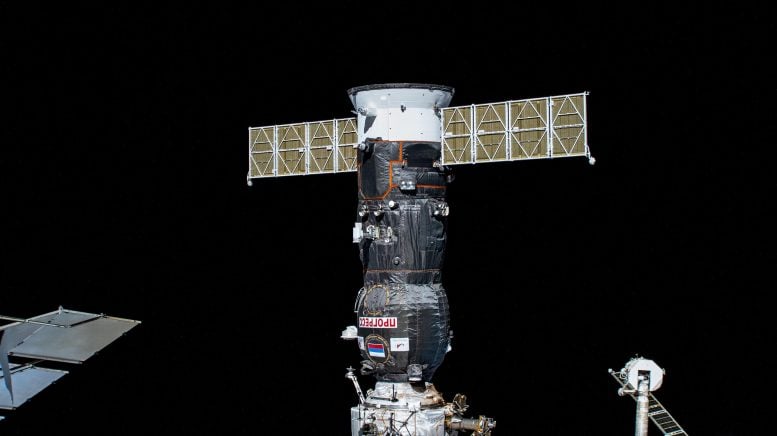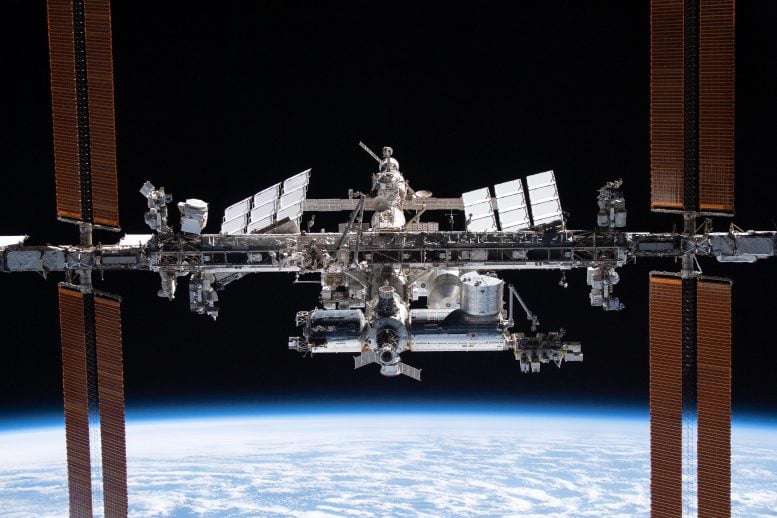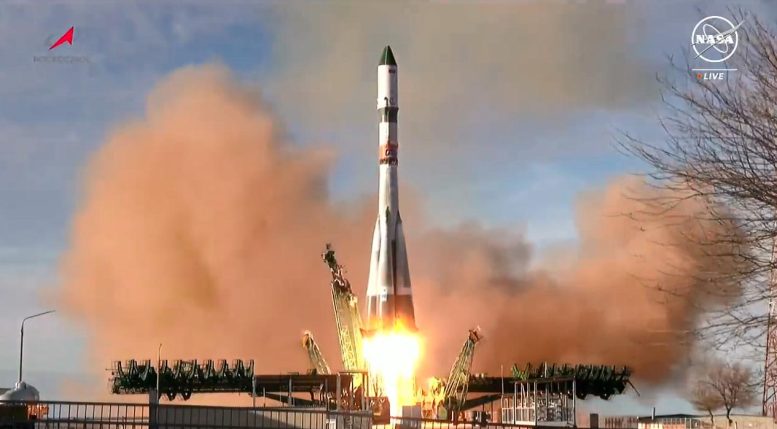Progress 86 Launches to International Space Station With Essential Supplies
The Progress 86 cargo craft launches to the station from the Baikonur Cosmodrome in Kazakhstan at 4:25 a.m. EST Friday, December 1. Credit: NASA TV
Roscosmos’s Progress 86 spacecraft launched successfully for the ISS, carrying nearly three tons of supplies. It’s set to dock on December 3, following successful deployment of its solar arrays and navigational antennas.
The uncrewed Roscosmos Progress 86 is safely in orbit headed for the International Space Station (ISS) following the launch at 4:25 a.m. EST Friday, December 1 (2:25 p.m. Baikonur time) from the Baikonur Cosmodrome in Kazakhstan.
The resupply ship reached preliminary orbit, and deployed its solar arrays and navigational antennas as planned, on its way to meet up with the orbiting laboratory and its Expedition 70 crew members.
Progress will dock to the station’s Poisk module on Sunday, December 3 at 6:14 a.m. EST. Live coverage on NASA TV of rendezvous and docking will begin at 5:30 a.m.
Progress will deliver almost three tons of food, fuel, and supplies to the space station.

The ISS Progress 84 cargo craft from Roscosmos is pictured docked to the International Space Station’s Poisk module. Credit: NASA
Progress Cargo Spacecraft
The Progress cargo spacecraft, developed by the Soviet Union and now operated by Russia, is an unmanned freighter designed to resupply the International Space Station (ISS). It carries supplies such as food, fuel, and equipment, and can also remove waste from the ISS. Progress spacecraft are launched atop Soyuz rockets and have been a crucial part of sustaining space station operations since the 1970s.
Roscosmos
Roscosmos, officially known as the Russian Federal Space Agency, is the governmental body responsible for Russia’s space science program and general aerospace research. Established after the dissolution of the Soviet Union, Roscosmos oversees all Russian space activities, including satellite launches, manned and unmanned space exploration, and the development of new space technology. It plays a key role in international space collaborations, particularly with the International Space Station.

The International Space Station is pictured from the SpaceX Crew Dragon Endeavour during a fly around of the orbiting lab that took place following its undocking from the Harmony module’s space-facing port on November 8, 2021. The orbital complex was flying 263 miles above the Marshall Islands in the Pacific Ocean when this photograph was taken. Credit: NASA
The International Space Station
The International Space Station (ISS) is a multi-national collaborative project involving five participating space agencies: NASA (United States), Roscosmos (Russia), JAXA (Japan), ESA (Europe), and CSA (Canada). Orbiting Earth, the ISS serves as a microgravity and space environment research laboratory where scientific research is conducted in astrobiology, astronomy, meteorology, physics, and other fields. The ISS is a testament to international cooperation in space exploration, continuously inhabited since November 2000.

The Progress 86 cargo craft launches to the station from the Baikonur Cosmodrome in Kazakhstan at 4:25 a.m. EST Friday, December 1. Credit: NASA TV
Roscosmos’s Progress 86 spacecraft launched successfully for the ISS, carrying nearly three tons of supplies. It’s set to dock on December 3, following successful deployment of its solar arrays and navigational antennas.
The uncrewed Roscosmos Progress 86 is safely in orbit headed for the International Space Station (ISS) following the launch at 4:25 a.m. EST Friday, December 1 (2:25 p.m. Baikonur time) from the Baikonur Cosmodrome in Kazakhstan.
The resupply ship reached preliminary orbit, and deployed its solar arrays and navigational antennas as planned, on its way to meet up with the orbiting laboratory and its Expedition 70 crew members.
Progress will dock to the station’s Poisk module on Sunday, December 3 at 6:14 a.m. EST. Live coverage on NASA TV of rendezvous and docking will begin at 5:30 a.m.
Progress will deliver almost three tons of food, fuel, and supplies to the space station.

The ISS Progress 84 cargo craft from Roscosmos is pictured docked to the International Space Station’s Poisk module. Credit: NASA
Progress Cargo Spacecraft
The Progress cargo spacecraft, developed by the Soviet Union and now operated by Russia, is an unmanned freighter designed to resupply the International Space Station (ISS). It carries supplies such as food, fuel, and equipment, and can also remove waste from the ISS. Progress spacecraft are launched atop Soyuz rockets and have been a crucial part of sustaining space station operations since the 1970s.
Roscosmos
Roscosmos, officially known as the Russian Federal Space Agency, is the governmental body responsible for Russia’s space science program and general aerospace research. Established after the dissolution of the Soviet Union, Roscosmos oversees all Russian space activities, including satellite launches, manned and unmanned space exploration, and the development of new space technology. It plays a key role in international space collaborations, particularly with the International Space Station.

The International Space Station is pictured from the SpaceX Crew Dragon Endeavour during a fly around of the orbiting lab that took place following its undocking from the Harmony module’s space-facing port on November 8, 2021. The orbital complex was flying 263 miles above the Marshall Islands in the Pacific Ocean when this photograph was taken. Credit: NASA
The International Space Station
The International Space Station (ISS) is a multi-national collaborative project involving five participating space agencies: NASA (United States), Roscosmos (Russia), JAXA (Japan), ESA (Europe), and CSA (Canada). Orbiting Earth, the ISS serves as a microgravity and space environment research laboratory where scientific research is conducted in astrobiology, astronomy, meteorology, physics, and other fields. The ISS is a testament to international cooperation in space exploration, continuously inhabited since November 2000.
